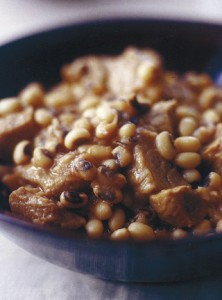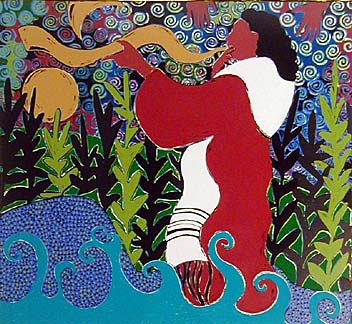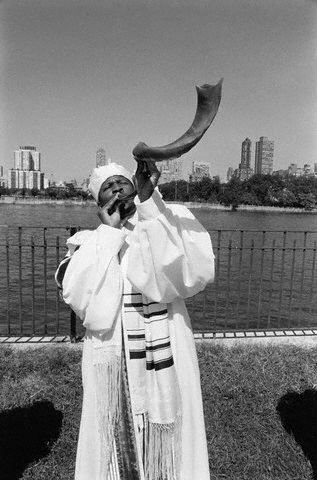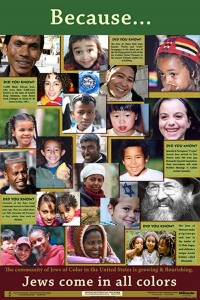“May It Be Your Will That Our Merits Increase Like The Black-Eyed Peas.”

Quentin Bacon, Photographer: ‘Aromas of Aleppo’
New Year’s Table: A tradition for Syrian Jews and those from the American South.
At Rosh Hashanah, Black-eyed Peas for Good Fortune by Devra Ferst, The Jewish Daily Forward
A Google search linking black-eyed peas and Jews reveals a wide discussion about the Jewish roots of the popular hip-hop band (sadly, none) and a riff on Lenny Bruce’s Jewish vs. goyish shtick that peas are Jewish while black-eyed ones are goyish.
But black-eyed peas are Jewish. Jews from both Syria and the American South eat them as part of a celebratory meal on Rosh Hashanah.
One tradition dates back to a 2,500-year-old text and the other crops up in the mid 20th century. Could the two be connected?
The peas — actually beans from the cowpea family — are white with a small black circle, or “eye,” near the base. Indigenous to West Africa, Ethiopia or the Far East (depending on your source), they made their way to Judea at least 500 years before the Common Era and were brought to America by slaves in the 17th century. When cooked alone they are relatively bland; however, being easy to grow and high in protein and carbohydrates makes them an inexpensive staple in Southern states and in the Middle East, though not much of a holiday treat.
Poopa Dweck, author of “Aromas of Aleppo” (HarperCollins, 2007), explains in her book that Syrian Jewish families begin the New Year with a Seder, a ceremony before a Rosh Hashanah meal. “The foods of the New Year holiday symbolize a wish for a sweet year. Aleppian Jews eat several symbolic foods during the Rosh Hashanah dinner… that correspond to the wishes of the Jewish people for the coming year,” she writes.
The tradition comes from the Babylonian Talmud, which states, “Abaye said, ‘Now that you have said that an omen is significant, at the beginning of each year, each person should accustom himself to eat gourds, black-eyed peas, fenugreek….” Each of the foods (nine in total) represents something different for the year ahead; the black-eyed peas symbolize good fortune. For a Syrian meal, they’re traditionally prepared in a simple recipe with garlic, onions and veal. The dish can be spiced up with cinnamon and allspice or flavored with tomatoes or tomato paste.
The dish symbolizes prosperity in ways: A single serving contains so many of the small beans and the dish’s name pays homage to abundance. Black-eyed peas are rubiyah (in Aramaic and Hebrew) or lubiya (in Arabic), which are cognates of the Hebrew words harbeh, meaning many, and l’harabot, to increase. The idea is to take in prosperity at the start of the year, with the hope that it will serve as a good omen for the year ahead. While the Syrian Jewish community is the only one to eat the beans in a Seder Rosh Hashanah, other Sephardic communities have adopted the tradition of the Rosh Hashanah beans.
This culinary tradition likely arrived in America with Sephardic Jews who moved to the South in the 18th century. Many Jews of the South had black cooks, who prepared a combination of what their Jewish owners or bosses requested and dishes from their own culinary traditions. In the case of black-eyed peas, those traditions overlapped, both groups having their own preparations of the beans. Though the two black-eyed pea traditions intersected in the early South, they didn’t meld into one; nor did one seem to rub off on the other.
Around the same time, the tradition of eating black-eyed peas January 1, still widely popular in the American South, was crystallizing in the surrounding non-Jewish communities. Hoppin’ John, a dish made with black-eyed peas, rice and pork, is eaten to obtain a prosperous year. It’s served in a meal alongside greens whose leaves symbolize paper money, thus wealth.
The sources of both the dish’s name and its symbolism have become the province of legend and lore. Some argue that the beans represent coins, while others argue that because they expand while cooking, they represent abundance. Southern food historian John Taylor explains that the combination of rice and beans in the dish came “with the enslaved” from Africa, while the tradition of eating them on “New Year’s probably came from the Caribbean, where they prepare a similar dish called Moros y Cristianos (Moors and Christians).”
The first recipe on record for the dish in the South is in “The Carolina Housewife,” from 1847, one of the nation’s earliest cookbooks. It’s likely, however, that the dish was prepared much earlier, particularly since its roots are in slave culinary traditions, which were maintained orally. Over time, the dish was adopted by white Southerners for whom the slaves cooked, and was incorporated into the greater Southern culinary canon, particularly of the low country in the Carolinas and parts of Virginia and Georgia.
More than 150 years later, the dish not only appears in households on secular New Year’s Day, but also in kosher variations on tables of Jewish families in the South celebrating the Jewish New Year. Jewish recipes (found in Sisterhood cookbooks from the South) often replace the pork with a smoked turkey leg, but there are also vegetarian preparations.
Marcie Cohen Ferris, author of “Matzoh Ball Gumbo” (University of North Carolina Press, 2005), explains that the tradition started in the 1960s: “On holidays, people cook traditionally, but there’s a group of people who like to add in regional flavors to give it a signature of place. What could be more of a symbolic dish than to grab that dish from the secular New Year’s and claim it for Rosh Hashanah?”
Ironically, it is by adopting this African-Caribbean-Southern-Christian tradition (possibly inflected by local Sephardim) that the Jews of the South are reclaiming and reconnecting to a Jewish tradition that dates back more than 2,000 years. Devra Ferst is the Forward’s editorial assistant. Original article can be read HERE.
Rosh Hashanah Egyptian Black-Eyed Peas by Diane Kaufman-Tobin
Ingredients:
1 onion, chopped
3 tablespoons sunflower oil
2 garlic cloves, minced or crushed in a press
1.5 lb (750g) lamb or veal, cubed
1 lb (500g) tomatoes, peeled and chopped
3 tablespoons tomato paste
1 lb (500g) dried black-eyed peas, soaked for 1 hour
1 teaspoon cinnamon
1/2 teaspoon allspice
Salt and pepper
1-2 teaspoons sugar
Directions:
Fry the onion in the oil till golden. Add the garlic, and when aroma rises add the meat. Stir to brown it all over. Add the tomatoes and tomato paste. Drain the black-eyed peas, and simmer on fresh water for 15 minutes, then drain and add them to the meat. Add cinnamon and allspice and cook for 2 hours, adding salt and pepper to taste and the sugar after about 1 hour.
L’shanah Tovah Tikatev V’taihatem!
May you be inscribed and sealed for a good year!
 Artist: Lynn Feldman ~ Serigraph: She Blew the Shofar
Artist: Lynn Feldman ~ Serigraph: She Blew the Shofar
L’shanah Tovah Tikatev V’taihatem!
May you be inscribed and sealed for a good year!
 Avinu malkeinu sh’ma kolenu
Avinu malkeinu sh’ma kolenu
Avinu malkeinu chatanu l’faneycha
Avinu malkeinu alkenu chamol aleynu
V’al olaleynu v’tapenu
Avinu malkeinu
Kaleh dever v’cherev v’raav mealeynu
Avinu malkeinu kalehchol tsar
Umastin mealeynu
Avinu malkeinu
Avinu malkeinu
Kotvenu b’sefer chayim tovim
Avinu malkeinu chadesh aleynu
Chadesh a leynu shanah tovah
Sh’ma kolenu
Sh’ma kolenu
Sh’ma kolenu
Avinu malkeinu
Avinu malkeinu
Chadesh a leynu
Shanah tovah
Avinu malkeinu
Sh’ma kolenu
Our Father Our King
Hear our prayer
We have sinned before thee
Have compassion upon us and upon our children
Help us bring an end to pestilence, war, and famine
Cause all hate and oppression to vanish from the earth
Inscribe us for blessing in the book of life
Let the new year be a good year for us
“Awake! Examine your deeds; repent and remember your Creator. Those of you who forget the truth and become involved only in vanity and emptiness, look into your souls; improve your ways and actions, forsake your evil path and negative thoughts.” (Maimonides, Laws of Repentance, Ch. 3)
Rosh Hashanah Talk on Multiculturalism by Bashari Rosenberg George
When I first got chosen to speak at Rosh Hashanah I was a little bit skeptical and unsure about whether I was asked for the right reasons. I thought it seemed a little too obvious for me to be the speaker. I am the “picture perfect” multicultural Jewish girl. Also, I’ve noticed a trend developing in the choice of speakers for Rosh Hashanah. The young person is always a girl, usually someone from JYCA (Jewish Youth for Community Action) and many have been participants in the FAITHS Youth
Leadership Initiative. Here I am, having just completed the FAITHS Initiative, a young black Jewish woman from JYCA! Everyone expected that I would speak. I felt I was being stereotyped, even though it was positive stereotype.
I thought about this dilemma and after having a long talk with my Mom I realized that I do have a lot to say about the subject of multiculturalism and Judaism. I shouldn’t let my discomfort or fear about being stereotyped stop me from using this opportunity to get the undivided attention of my community for seven whole minutes! PAUSE
I appreciate the honor of speaking at Rosh Hashanah. I am thankful to be part of a Jewish community that thinks that multiculturalism is so important and I am glad that Kehilla supports women and youth being up on the beema. But sometimes I think we try too hard to be “politically correct” and cover all the bases, so I feel that I’m expected to speak not only for youth and for women, but also for the “people of color” in our community. I think that often people take the visible things about me and only see what’s on the surface. Then, they act like they know me, but we’ve never actually formed a real relationship. They label me by what they may have heard -I’m a dancer, I’m a youth activist, I’m a Black Jew.
Even within JYCA, where I feel safe and completely loved, sometimes I am forced to be the representative of a group that I don’t feel I belong to. For example, on JYCA retreats sometimes we do different types of workshops. On one retreat TODOS Institute led a diversity training. We were divided into caucus groups of people who’ve been targets of oppression and oppressors. The goal was for the targeted people to speak about how they’ve been oppressed, to see how the other groups could ally with them. Some of the target groups were women, LGBTQ, youth and people of color. I felt forced to assume the identity of a “person of color” which is not actually how I identify myself. I felt I was being used as a token person so that the training could proceed, which is the opposite of what a diversity training should be. I felt artificially separated from my friends. I don’t especially feel oppressed as a Black person or as a bi-racial person – maybe more as a young person. Racism isn’t usually aimed at me so much as at people who have less money and opportunities than I do. There are many other factors that go into who is targeted, and this kind of approach oversimplifies the issue.
I don’t especially see myself as a Black Jew or even as Black and Jewish. In this country, people hear and see Black and think African American and fill in all the history of coming up from slavery in the United States. Culturally and ethnically that’s not what I am. It’s not that I am running away from that identity. If I pretended to be African American, I would be untrue to myself. When people ask me what I am, I say Trinidadian and Russian Jew, and that’s still a simplification of my background. My father is from Trinidad, the southernmost island in the Caribbean off the coast of Venezuela. Trinidad is an extremely multicultural place – including Africans, Indians, Chinese, South Americans, Europeans and Arab Jews. My father’s background is very mixed – my great-grandparents on his side include French, Irish, and Huarahu Indian from Venezuela, a Ghanaian trader and Africans brought as slaves to work on the sugarcane plantations. My mother’s family are all Jews from Russia, even though I suspect there’s more mixture in there than we know. My Bubbie’s mother had Asian eyes, high prominent cheekbones and jet-black hair. My great uncle Israel, when he became old and bald, could easily have been mistaken for Chinese. Were we mixed with Asian Jews coming up through Mongolia into Georgia? Were we partly the result of violence and pogroms? We’ll probably never know.
We need to ask ourselves how the Jewish people, in our migration from North Africa, have become the varied mixture of people we see today. How did a brown skinned Semitic tribe miraculously become “white” with European features? And what about all the other Jews around the world – the Arab, African and Asian Jews? Look around this room at the variety of features, hair textures and skin tones. We are all multicultural Jews. I challenge each of you to take the time to look deep into your own heritage and background- farther back than the last few hundred years. Where does your identity end?
I’ve often challenged my mother when she says someone “looks Jewish”. Usually she means someone who is from New York of Eastern European descent. I say, “Look at me, do I look Jewish?” and she usually says, “Yes! You have very Jewish features.” But the world doesn’t look at me that way. It is not often assumed that I’m Jewish, even though I frequently wear one of the many beautiful Jewish stars my godmother, Hedy, has given to me. At school, sometimes people will say, “I love your necklace – what is it, a flower?” When I reply, “No, actually it’s a Jewish star,” their response is usually, “Oh! You’re Jewish?, or “You don’t look Jewish,” or some other expression of surprise. And I feel like, here we go again, I have to explain myself all over again. Where do I start… how much should I reveal of myself… does this person really care? It’s not just about looking Jewish, it’s about all the racial categories. People are so quick to say, “What are you?” expecting a one word racial definition. That’s not the answer I want to give. Race can’t substitute for taking the time to get to know who people really are. We need to challenge the whole way we see the world through racial eyes.
It’s interesting to me to have traveled to places in the world where nearly everyone seems mixed. For instance, I just came back from Toronto, where there are so many different kinds of people it was hard to even guess a person’s ethnicity, and after a while you stopped caring. Or, in Cuba, where people all think of themselves as Cuban and they’re proud of that identity. People there aren’t always separating themselves by their history. In lots of other places I have visited in the world I feel more comfortable than I do in America. I was more of the norm, and even when I wasn’t, people didn’t trip off of it. I think part of the problem in America is that it’s hard to find a common culture to belong to except for consumerism. There’s the old myth about “the American dream” but that hardly applies to everyone, so people feel the need to identify themselves some other way. Everyone wants to belong to something. Maybe that’s why we’re so divided. People construct racial categories as a way of distinguishing themselves. And that makes it easier for those in power to divide and conquer us. I want to especially call attention to the Arabs who in this day and time are being scapegoated, harassed and threatened. As Jews, who have so often been the subject of mistreatment, we should be able to relate to this. In the face of a violent world we need to find a way to stand together and overcome our differences. Within the human family the Arabs are definitely our cousins. Besides, it’s scientifically proven that race doesn’t even exist. The Human Genome project has shown that 99.9% of human genetic material is the same in every one of us. Underneath it all, we are all one species and our differences should be recognized and cherished instead of being used to categorize us.
Within this society that is so confused about race, I’ve found an interesting way to determine my self-identity and to deal with the identity crisis I am “supposed to” experience. In fact, I don’t feel torn or forced to choose. I don’t consider myself as half Black and half white, or part Trinidadian and part Jewish, or even as bi-racial. I consider myself a whole something else. Because I’m from the Bay Area I’ve been able to find close friends with similar backgrounds to mine who I can share my experiences with. We’ve created our own culture.
We consider ourselves SKITTLES – we represent all different colors, all different shades and flavors. The name “SKITTLES” originated when I was at a concert with a mixed group of friends, we were all wearing bright colors – pink, red, orange and blue, and I made a joke that we looked like SKITTLES – the rainbow candy. Then we realized that it actually went deeper than that. Over time we’ve had different chances to explore this idea – through Destiny Arts Center and the Hapa Club at Berkeley High. We recognize each other as SKITTLES – it’s a spicy attitude and a pride in who we are without being defined by how others see us. The name SKITTLES is starting to travel beyond our little clique. It’s even gotten into the broader culture of Berkeley High, and was included in a student-made slang dictionary. Whether or not people understand it, I prefer to define myself as a SKITTLE.
I guess if I were trying to put this all into one pretty little package about multiculturalism I would say, “Get to know each person as an individual.” Even though you’ll probably first judge someone by looking at them, don’t let that impression make you categorize them and don’t let it substitute for getting a closer look. And if by chance you want to get to know me as an individual, don’t just see the JYCA member, Destiny dancer and activist Bashari. Those activities and interests don’t define me, as those kinds of interests don’t define anyone. If you want to know me, come up and start a conversation. But as a personal favor, please don’t tell me that I am inspiring; tell me what I inspire in you. Don’t tell me what your perception of me is. Tell me your opinions, your interests and your ideas. Help me get to know you, not for who you represent but as an individual.
May all of us be listened to & embraced & welcomed & supported – in the coming year.


